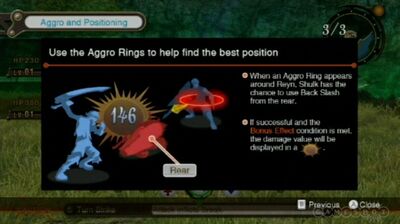
The game's explanation of aggro
Aggro (Japanese: ヘイト, Heito, Hate; English dub: /ˈæɡroʊ/) is a stat that draws 敌人 towards a member in the party. Using Battle Arts will raise aggro of 敌人. The member with highest aggro will be targeted by the 敌人. There are some arts that will increase, decrease, eliminate, or absorb aggro.
Certain characters such as Reyn, Dunban and Fiora are used to gain aggro so that 其它 characters can find a better position. The three mentioned character will either have high defence and HP (Reyn) to attract 敌人 attacks, or high agility (Dunban and Fiora) to dodge the attacks.
Contents
Damage
Under normal circumstances, every point of damage done to a Monster increases aggro by 0.5 point on that monster's aggro table.
治疗
Under normal circumstances, every 1 point healed makes 1.25 points of aggro.
Recovery Up gems increase the amount the target will be healed by, which causes more aggro. If Melia's 治疗 Gift heals for 1740, that will result in 2175 points of aggro (from the 治疗 only). If Melia's target uses a Rank VI Recovery Up gem to increase 治疗 by half, 治疗 Gift will now heal 2,610 which results in 3,262 points of aggro.
No aggro is generated from 治疗 as a result of regeneration (Such as Melia's Summon Aqua, or Aura Heal gems) or encouraging an ally during battle (such as when encouraging with Reyn's 治疗 Inspiration is skill linked).
Further testing needs to be done to establish how much aggro is gained during which instances of 治疗 (for example, arts versus gems) and who gains the aggro.
Receiving Damage
When a party member is the target of an enemy's aggro, they will lose 2 points of aggro for every 1 point of damage received from that 敌人 under normal circumstances. So if somebody 吸引 aggro off the tank and they get hurt enough damage by the 敌人, aggro will return to the tank (provided they do nothing else to produce aggro).
NOTE: Receiving Spike damage does NOT reduce aggro for a party member.
NOTE: Reyn's Anchor Chain aura completely negates any aggro Reyn will lose when taking damage.
NOTE: Shulk's Forced Mercy skill increases the amount of aggro reduced by 25% per hit.
For example, under normal circumstances say Shulk was to hit an 敌人 for 1 damage, Reyn hits the same 敌人 for 4,000 damage, and no further actions are taken by them. At this point Shulk would have 1 point of aggro, and Reyn would have 4,000, meaning the 敌人 would attack Reyn because he has the most aggro. Now if the 敌人 were to hit Reyn until Reyn receives 2,000 damage, something weird happens & Shulk suddenly becomes the target of aggro. This happens because taking damage reduces aggro by twice whatever damage is received.
For a different example, if Dunban were to hit an 敌人 for 8,000 damage, Riki hits the same 敌人 for 9,000 damage, and this 敌人 hits Riki for 700 damage, Dunban would be the aggro target in the end. When Riki is hit for 700 damage, that lowers his aggro by 1,400 points. Since Riki had 9,000 points of aggro originally, but he loses 1,400 points (from taking 700 damage), he ultimately has 7,600 points of aggro which is less than the 8,000 Dunban has.
This Mechanic was almost surely implemented so that any party member that was not in a tank role that accidentally gets the most aggro, will later lose aggro after a few hits so the aggro will return to the tank.
This is one of the factors that allows Dunban to hold aggro when he is in the tank role, especially in the middle of the game. As Dunban's survival when tanking is dependent on avoiding 物理 damage by dodging as much as possible, he receives less 物理 damage and therefore loses less aggro.
For Reyn, at first this seems to be a disadvantage. If Reyn is in a tank role he must both achieve and maintain the most aggro. But if Reyn takes massive amounts of damage, he will lose twice that amount in aggro, making his job as tank that much harder. The only saving grace to this seems to be that Reyn has passive skills that increase his talent gauge (used for Mad 嘲讽) and tension when hit. In spite of this disadvantage where twice the aggro is lost as damage received, there are several strategies to increase Reyn's usefulness as a tank that may not be obvious, besides negating this disadvantage with Reyn's Anchor Chain aura. Reyn's aggro generation truly shines near the end game when he is loaded up with as much strength as possible and activates a maxed out 发狂的 aura, which increases strength by a rather large 210%. Compound this by increasing Reyn's damage mitigation with increased armour & skills, and Reyn becomes an 优秀 tank.
Arts
In addition to damage aggro, most arts, including auras, generate volatile aggro beyond any damage or 治疗 they might do. The amount of volatile aggro generated is dependent on the characters' level. This type of aggro dissipates at a rate of 60 points per second. For example if a Level 50 Melia were to use her Reflection art, she would generate a total of 1600 volatile aggro.
Although the exact formula for calculating the arts volatile aggro is not known, this formula is a good approximation: arts volatile aggro = arts volatile aggro parameter × (character's level + 14).
The parameters can be found here at the Japanese Wiki, listed in the "Hate" category. The rest of this list is pertaining to arts that have extra special modifiers for aggro. The question mark means nothing has been confirmed.
| Effect | Character | Art | Amount |
|---|---|---|---|
| Reduce Aggro | Dunban | Heat Haze | 100% |
| Riki | Play Dead | 100% | |
| Sharla | Covert Stance | 25% to 52%. No aggro gain for duration. | |
| Shulk | Shadow Eye | 30% to 75% | |
| Absorb Aggro | Dunban | Blinding Blossom | 20% to 56% |
| Increase Aggro | Dunban | Battle Eye | Lock-On |
| Dunban | Peerless | Depends on Dunban's level. Volatile aggro is added to 敌人 around Dunban. | |
| Fiora | Lock On | Lock-On | |
| Reyn | Anchor Chain | Reyn's static aggro is added to each 敌人 engaged in battle at a rate of 200 per second. | |
| Reyn | 光环爆发 | Depends on Reyn's level for each 敌人 hit. | |
| Reyn | Engage | Lock-On and +25% to Mad 嘲讽 | |
| Reyn | Hammer Beat | Depends on Reyn's level for each 敌人 hit. | |
| Reyn | Mad 嘲讽 | Depends on Reyn's level. Mad 嘲讽 aggro's dissipation rate per second is 1/30th of the total. Mad 嘲讽 aggro reaches 0 after 30 seconds. |


